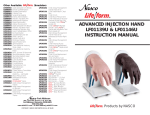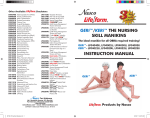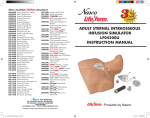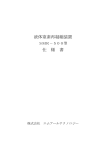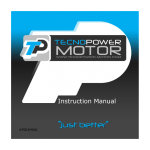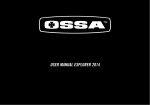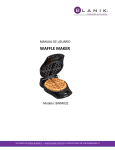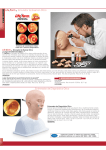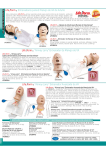Download LF04001U Geri™ The Complete Nursing Skills Manikin Manual
Transcript
Other Available LF00698U LF00856U LF00901U LF00906U LF00929U LF00957U LF00958U LF00961U LF00984U LF00995U LF00997U LF00999U LF01008U LF01012U LF01019U LF01020U LF01025U LF01026U LF01027U LF01028U LF01036U LF01053U LF01054U LF01062U LF01063U LF01064U LF01069U LF01070U LF01082U LF01083U LF01084U LF01087U LF01095U LF01108U LF01142U LF01162U LF03000U LF03601U LF03602U LF03603U LF03609U Adult Injectable Arm (White) Female Catheterization Prostate Examination Ostomy Care Surgical Bandaging Enema Administration Pediatric Injectable Arm Intramuscular Injection Breast Examination Arterial Puncture Arm Adult Injectable Arm (Black) Pediatric Injectable Head Intradermal Injection Arm Heart Catheterization (TPN) Ear Examination Supplementary Ear Set Male Cath-Ed I Female Cath-Ed II Peritoneal Dialysis Suture Practice Arm Spinal Injection Cross-Sectional Anatomy, Torso, Head Cross-Sectional Anatomy, Head Pelvic, Normal & Abnormal Stump Bandaging, Upper Stump Bandaging, Lower Cervical Effacement Birthing Station Cricothyrotomy Tracheostomy Care Sigmoidoscopic Examination Central Venous Cannulation Blood Pressure Arm Intraosseous Infusion Simulator Auscultation Trainer Venatech IV Trainer CPARLENE® Series Adult Airway Management Trainer Adult Airway Management on Manikin Adult Airway Management Head Only Child Airway Management Trainer Simulators LF03610U Child Airway Management Trainer Head Only LF03611U Child Defibrillation Chest Skin LF03612U Child IV Arm LF03613U Child Blood Pressure Arm LF03614U Child Intraosseous Infusion/ Femoral Access Leg Only LF03615U Complete Child CRiSis™ Update Kit LF03616U Child CRiSis™ Manikin LF03617U Deluxe Child CRiSis™ Manikin with Arrhythmia Tutor LF03620U PALS Update Kit LF03621U Infant Airway Management Trainer Head Only LF03622U Intraosseous Infusion Right Leg LF03623U Infant Airway Management Trainer LF03626U Child Femoral Access Injection Pad Replacement LF03632U Child Intraosseous Infusion/ Femoral Access Leg on a Stand LF03633U Child Airway Management Trainer with Torso LF03693U Basic Buddy CPR Manikin LF03699U “Airway Larry” Airway Management Trainer LF03720U Baby Buddy Infant CPR Manikin LF03953U CRiSis™ Manikin LF03955U Deluxe CRiSis™ Manikin LF04001U GERi™ Nursing Manikin LF04020U KERi™ Nursing Manikin LF04021U KERi™ Basic Manikin LF04022U KERi™ Advanced Manikin LF04030U GERi™ Advanced Manikin LF04040U GERi™ Basic Manikin Geri™ THE NURSING SKILLS MANIKIN LF04001U INSTRUCTION MANUAL Fort Atkinson 901 Janesville Avenue, P.O. Box 901 Fort Atkinson, Wisconsin 53538-0901 1-800-558-9595 www.eNASCO.com • E-mail: [email protected] COPYRIGHT © NASCO 1998 PRINTED IN U.S.A. NP 114-93/RV 9-01 Products by NASCO Figure 1 Congratulations for choosing Geri™, the nursing skills manikin to teach your students patient care techniques. GERI’s™ simple design makes the manikin easy to use and care for. Many unique features are included with this manikin, so please familiarize yourself with this manual before using Geri™ with your students. List of Components: GERI™ Manikin Male genitalia Female genitalia Wig Hearing Aid Fluid drainage basin Catheter bag with fitting and pressure sleeve 12 cc syringe Serial number — under skin at the back of the neck Spray lubricant The legs detach from the body at the hips by bending the legs backward approximately 150° so that the feet are near the shoulders and the keyholes are aligned (Figure 2). Then pull outward away from the body. Reverse this procedure to reassemble. Figure 2 The head may be removed by rotating it 180° backward to align the key holes, and then pulling up. The internal stomach reservoir will come out of the body General Instructions For Care: through the neck opening. Reverse this GERI™ comes completely assembled but procedure to reassemble. is simple to take apart if need be. Arms can be removed by bending the elbows All other joints may be disassembled with backward approximately 90° to align the a flat-head screwdriver. Hold the opposite keyholes at the shoulders (Figure 1). Then end of the connector pin to prevent pull outward away from the shoulder of unproductive rotation. the manikin. Reverse this procedure to reassemble. The intramuscular injection pads located Maximum capacity of at the shoulders, thigh, and hip may be internal reservoirs: removed by compressing them sideways Ileostomy 20cc and pulling up. The eyes may be removed Colostomy 20cc by creasing the skin at the outside of each Urinary 375cc eye and rolling the eye up (Figure 3). Rectal 775cc Stomach 375cc Visual Inspection Features: Reddened skin under right breast Moles on back — the upper center mole is normal. The lower outer mole shows signs of malignancy. Sacral decubitus ulcer — stage 1 Figure 3 Pupils — left is dilated; right is constricted The wig may be washed with cool water and a mild shampoo. Blot with a towel and air dry. The wig is held in place by elastic at the front and rear of the male hairline. Do not brush the wig when it is wet. Most cleaning can be done with a soft cloth and warm water. Avoid washing the painted areas on the manikin. Stubborn stains can be treated by using REN cleaner and a soft rag. Stains caused by makeup, ink, and newsprint are indelible and cannot be removed. Avoid contact with these substances. Do not apply cosmetics or Betadine solution to the manikin. All internal reservoir bags may be disinfected by rinsing with a solution of 10% bleach and water. Patient Care Simulations Male Catheterization NOTE: To avoid the possibility of leakage, make sure you use the 16 French Foley catheter supplied with the simulator. The male genital insert represents an uncircumcised adult male. To prepare for catheterization exercises, fill the 140cc syringe (supplied) with water. Lubricate the end of the administration tube and insert through the urethra at least 7"-8". Be sure the catheter bag and fitting are attached to the urethra behind the genital insert. The velcro on the catheter bag should be secured to the velcro on the genital track. Depress the plunger of the syringe to fill the catheter bag. The catheter bag has a capacity of approximately 375cc. Intramuscular Injections Intramuscular injections may be performed in inserts at the left hip, right thigh, and at both shoulders. Inject air only, as these inserts cannot be drained. To remove the injection inserts compress them sideways and pull out. Intravenous Injections An optional right arm may be purchased for IV training. This arm features realistic soft vinyl skin and latex veins, which are completely replaceable. The arm rotates at the elbow for easy accessibility to the antecubital fossa, along the forearm, and at the back of the hand. A bony landmark at the shoulder identifies soft tissue for intramuscular injections. Reference NASCO product #LF03214U. Blood Pressure Training An optional left arm may be purchased for training in taking blood pressures. The arm contains an internal speaker which produces realistic blood pressure sounds. The instructor can set any systolic and diastolic rates, adjust volume, and change the heart rate. The five Korotkoff sounds are produced and the instructor can select a mode for producing an auscultatory gap if desired. Reference NASCO product #LF03204U. Range of Motion One of the most unique features of the KERi™ manikin is the complete and realistic range of motion provided at all the joints. This allows for correct patient positioning and flexibility exercises. The manikin’s articulation includes: Trunk — Rotation, Hyperextension Shoulder — Abduction, Adduction, Rotation, Hyperextension Elbow — Extension, Flexion, Pronation, Supination Wrist — Flexion, Hyperextension,Radial Flexion, Ulnar Flexion Fingers — Abduction, Adduction, Flexion (soft, lifelike material) Neck — Rotation, Hyperextension, Lateral Flexion Hip — Abduction, Adduction, Rotation, Hyperextension Knee — Extension, Flexion Ankle — Eversion, Inversion, Dorsiflexion, Plantarflexion Toes — Abduction, Adduction, Flexion (soft, lifelike material) Figure 4 Place the track on the track mount located at the underside of the abdomen. Gently slide the genital insert back to the body. Lift and push the bottom of the genital insert into the genital opening in the body. Push the top of the genital insert down and in to secure the system. The natural restrictions of the male urinary tract have been designed into the male genital insert, so proper manipulation of the penis is required to achieve catheterization. Thoroughly lubricate the 16 French Foley catheter (supplied with your simulator) prior to insertion. Insert the catheter about 2" into the urethra until the restriction of the mucosal fold is encountered. Withdraw the catheter slightly, stretch the penis slightly, and then advance the catheter past the first restriction. Advance the catheter approximately 2 additional inches until you feel the restriction of the bulbous urethra. Elevate the penis to about 60° and advance the catheter past the second restriction. The final restriction represents the sphincter muscle where the urethra joins the bladder. Gently advance the catheter past this point until you feel a “pop” as you enter the bladder. Water will now flow through the catheter into an external drainage basin. NOTE: Special care should be taken when using a Foley catheter. Cuff inflation should only be attempted when it is in the proper position inside the bladder. Just as in a real patient, the cuff must be completely deflated before the catheter is removed. Improper use of a Foley catheter can result in damage to the simulator. Leaving a catheter in the simulator may result in damage to the simulator. After completion of the exercise, remove the male genital insert by reversing the assembly instructions (page 2). Disconnect the catheter bag and fitting from the insert piece. Drain the bag thoroughly. Rinse bag and the outside of the penis to remove any residual lubricant. Prostate Examination The male genitalia also includes the capability for digital rectal prostate palpation. The prostate gland represents stage B progression of prostatic cancer. A discrete hard nodule is palpable in the upper right quadrant, simulating a beginning stage of carcinoma. The student must fully lubricate his or her finger prior to insertion into the rectum. The rectum should be rinsed with warm water after completion of the exercise. The male rectum does not have the capacity for enema administration. Female Catheterization NOTE: To avoid the possibility of leakage, make sure you use the 16 French Foley catheter supplied with the simulator. To prepare for female catheterization, fill the 140cc syringe (supplied) with water. Lubricate the end of the administration tube and insert through the urethra at least 7"-8". Be sure the catheter bag and fitting are attached to the urethra behind the genital insert. The velcro on the catheter bag should be secured to the velcro on the genital track. Depress the plunger of the syringe to fill the catheter bag. The catheter bag has a capacity of approximately 375cc. Place the track on the track mount located at the underside of the abdomen. Gently slide the genital insert back to the body. Lift and push the bottom of the genital insert into the genital opening in the body. Push the top of the genital insert down and in to secure the system. Thoroughly lubricate the 16 French Foley catheter (supplied with your simulator) prior to insertion. NOTE: Special care should be taken when using a Foley catheter. Cuff inflation should only be attempted when it is in the proper position inside the bladder. Just as in a real patient, the cuff must be completely deflated before the catheter is removed. Improper use of a Foley catheter can result in damage to the simulator. Leaving a catheter in the simulator may result in damage to the simulator. Enema Administration Enema administration can be practiced on the female genital insert only. To prepare the manikin for enema exercises, be sure the enema reservoir is securely attached to the inside of the rectum. Position the manikin on its left side in the Simm’s Position. Lubricate the applicator liberally and gently insert through the anus. Administer water only into the rectum. To simplify cleanup, you may choose to leave the applicator in place while positioning the manikin over a drainage basin. The rectum will drain via gravity as soon as the manikin leaves the left Simm’s position. Be sure to have a basin under the manikin. and visual inspection of the vagina and cervix may be demonstrated on Geri™ but, again, extreme care should be taken to thoroughly lubricate any instrument of insertion. Use the smallest possible speculum and avoid exerting too much pressure on the vaginal walls. Overexertion will damage the simulator just as it would cause tissue damage in an actual patient. The speculum must be thoroughly lubricated prior to insertion. The vagina should be rinsed with warm water after completion of the exercise to remove any residual lubricant. Ostomy Care Colostomy and ileostomy care can be practiced on Geri™, including stoma dilation, irrigation, cleaning, and ostomy bag changing procedures. Irrigation tubes should be well lubricated prior to insertion, and the stomas should be rinsed with warm water after completion of the exercise to remove any residual lubricant. The fluid capacity of the stoma reservoirs is 20cc. Removal of the internal stoma reservoirs can be achieved by removing the genitalia, and reaching through the genital cavity (Figure 5). The reservoir bags are attached directly to the underside of the stomas. To remove, pull the reservoir fittings down and disconnect from the stomas. Then pull the reservoir bags from the velcro attachments. Rinse with water to clean. Reverse the procedure to reattach the internal stoma reservoirs. Tracheostomy Care The tracheostomy canal is not removable from the body, so any water administered to this site must be suctioned out after completion of the exercise. Suctioning, dressing changes, tracheostomy tube placement, and cuff inflation may be practiced on the manikin. The tracheostomy canal is not connected to the oronasal system, and access is provided only through the stoma site. Oral Hygiene Tooth brushing should be performed without water or any cleaning agents to avoid leaking into the head of the manikin, and to simplify cleanup. Denture removal is Oral and Nasal Lavage, Gavage, accomplished by grasping the dentures, and Suctioning pulling forward and then down (for the Access to the stomach is provided through upper plate), or forward and then up (for the mouth and both nostrils.The insertion the lower plate). of any type of tube or instrument requires generous lubrication prior to insertion. Eye Irrigation Only water should be used in tube feed- Both eyes may be irrigated using water ing exercises. The internal stomach reser- only. The left pupil is dilated and the right voir has a capacity of 375cc. The stom- pupil is constricted. To dry the eye sockets ach may be emptied by suctioning the after completion of the irrigation exercise, remove the eyes by creasing the skin at contents (water). the outside of each eye and then roll the The stomach can be removed by rotating eye upward toward the nose. Pat the the head 180° backward to align the key inside of the eye sockets with a soft cloth holes in the neck, and then pulling up to remove moisture and replace the eyes (Figure 6). The stomach reservoir will in their respective sockets. come through the neck opening only if less than 250cc of water is contained in Ear Care Both ears may be irrigated using water the stomach. only. To drain, tilt the head sideways and empty into a basin or onto an absorbent cloth. Cotton swabs should be used carefully and only on the outer ear. Rinse the anus and internal rectal reservoir to remove any residual lubricant. Douching, Pap Smears, and Vaginal Inspection The female genitalia also allows for douching, but extreme care should be taken to lubricate the applicator thoroughly. Only water should be used as a douching agent. Pap Smear procedures Figure 5 When administering water to the internal stomach reservoirs, and when the stomach reservoir contains water, the head and upper torso should be at least slightly elevated to prevent backflow into the head of the manikin. Figure 6 Bed Baths and Hair Washing To simplify cleanup, dry bed baths and shampoos are recommended to eliminate the chance of water entering the inside of the manikin. However, a soft cloth and water can be used for bathing exercises, and a mild shampoo and cool water can be used for hair washing. Avoid scrubbing any painted areas of the manikin. To dry the wig, blot with a soft towel and air dry. Do not brush the hair when wet and never use a hair blower or dryer on the wig.






